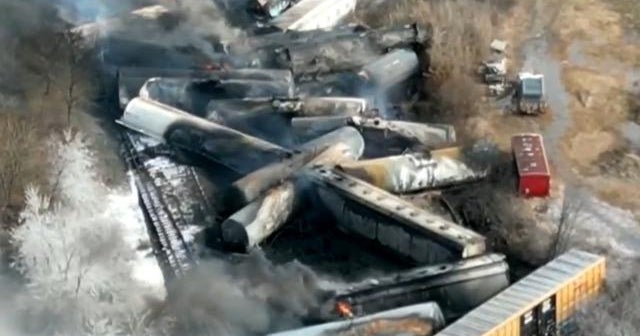Video showed wheel bearing was in

The National Transportation Safety Board released a preliminary report Thursday about the toxic train derailment earlier this month in East Palestine, Ohio. Thirty-eight cars derailed in the Feb. 3 crash, including 11 tank cars carrying chemicals including vinyl chloride.
“NTSB investigators identified and examined the first railcar to derail, the 23rd railcar in the consist,” the NTSB report said. “Surveillance video from a local residence showed what appeared to be a wheel bearing in the final stage of overheat failure
moments before the derailment.”
It said the wheel bearing and affected wheelset have been collected as evidence and will be a focus of further investigation.
According to the report, the train was traveling 47 miles per hour, slightly below the 50 mile per hour speed limit, but the alarm for a hot axle was triggered three times.
At first, the axle was 38 degrees above ambient temperature, according to recordings taken by a wayside defect detector, also called a hot bearing detector (HBD). By the second alert, the axle was 103 degrees above ambient tempreature. When the third alert went off, it was 253 degrees above ambient.
According to the NTSB, a recorded temperature 200 degrees above ambient is considered “critical” and the train must stop.
The HBD “transmitted an audible alarm message instructing the crew to slow and stop the train” after registering the critical temperature, the NTSB said.
The train came to a stop. Crew then observed fire and smoke and notified dispatchers of a possible derailment.
Read the report:
The agency’s ongoing investigation will look at the tank car design and derailment damage and review the accident response, including the decision to vent and burn vinyl chloride. The train was carrying 115,580 gallons of the substance across five cars at the time of the derailment, the NTSP report said. The temperature in one of those cars continued to rise, concerning authorities, because the temperature increase suggested the chemical could be undergoing a reaction that would pose an explosion hazard.
After expanding the evacuation area from one mile to two, responders scheduled a controlled venting of the five cars. This released and burned the chloride, a process that took several hours on Friday, Feb. 6.
The NTSB will also look at railcar design, maintenance procedures and practices, and Norfolk Southern’s inspection practices and use of wayside defect detectors.
Since the derailment, residents of East Palestine have expressed concern about the environmental impacts of the crash, and Norfolk Southern, the company that operated the train, said tons of contaminated material have been removed from the crash site.
Share this news on your Fb,Twitter and Whatsapp
Times News Network:Latest News Headlines
Times News Network||Health||New York||USA News||Technology||World News